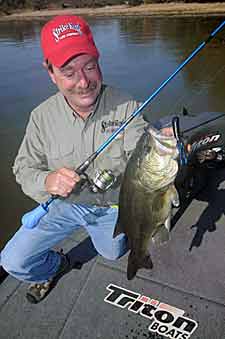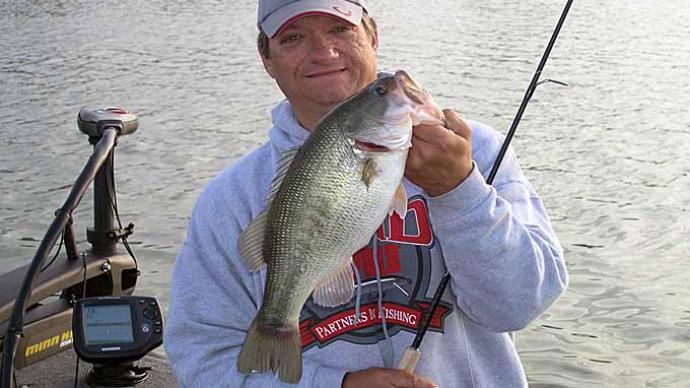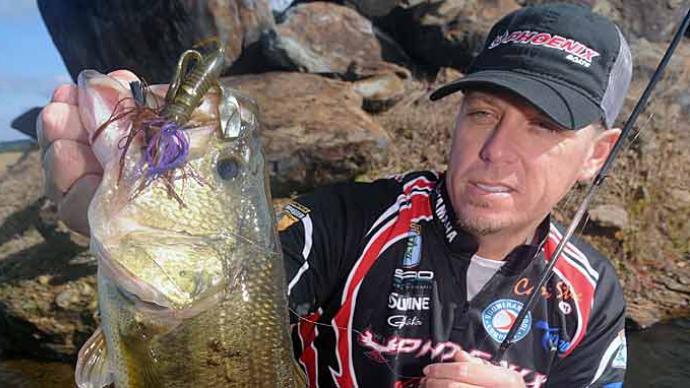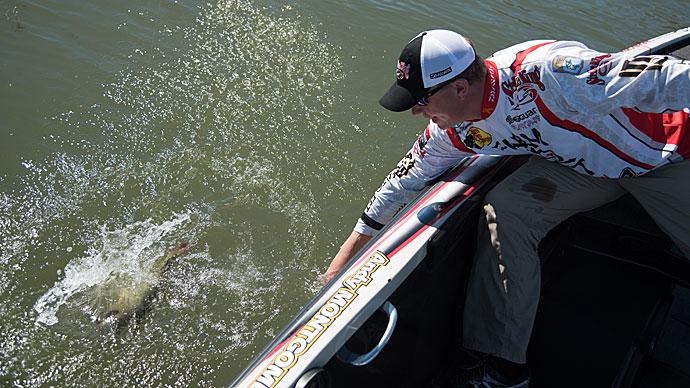
Florida pro Shaw Grigsby claims the art of skipping a lure has played an integral part in most of his Bassmaster tournament victories.
“That has been one of my go-to deals since I won my first (Bassmaster tournament) back in 1988,” says Grigsby. Looking back at his nine B.A.S.S. wins, Grigsby can recall only one victory where skipping wasn’t a part of the winning formula.
The touring pro counts on skipping a lure because it allows him to put the bait in places unreachable with a standard cast. It mimics the action of baitfish jumping out of the water, “It gets (bass) excited and triggers a strike because it looks like some minnows running away from a predator,” Grigsby says. “I have had several situations where I could get strikes only on a skip cast. If I made a normal cast, the fish wouldn’t care about it, but if I skipped it by them, they would suck it in right on top.”
Whenever he needs to skip a jig into thick cover, Grigsby relies on baitcast tackle. However, he favors skipping with spinning tackle for most of his soft plastic lure presentations. Grigsby notes the ease of skipping with spinning tackle is its most significant advantage over baitcasting gear. “With a baitcaster, you have to be perfect, “Grigsby says. With spinning tackle, there is no need to worry about hitting the water too hard or hitting something during the skip, which would cause backlashes if you were using a baitcaster.
During his early days of skipping, Grigsby had to finesse fish with 8- or 10-pound monofilament and lighter spinning tackle. “The advent of braid has changed spinning tackle from being a wimpy stick to something that has some power and can be used in so many different ways,” says Grigsby. He now uses a 6-foot, 10-inch medium-heavy action Quantum rod Shaw Grigsby rod and Quantum spinning reel filled with 20-pound Seaguar Smackdown braid for his skipping tactics.
Grigsby ranks tube baits such as the Strike King KVD Pro-Model Tube and Flip-N-Tube as the easiest lures to skip. His go-to bait for skipping is a Texas-rigged Strike King Rage Bug impaled on a 5/0 or 6/0 Lazer Trokar TK130 flipping hook. The B.A.S.S. pro recommends pegging the sinker on Texas-rigged soft plastics to prevent the lure from sliding away from the weight during the skip. He also suggests using lighter weights (1/16- or 1/8-ounce) for skipping soft plastics. “The heavier the weight, the harder it is to skip,” Grigsby says.

Skipping a lure requires the same arm motion you used as a kid when hopping stones across the water. Grigsby starts with his rod tip at about the 7 o’clock position and acts as if he is drawing a circle with his rod tip. Keeping his rod low to the water, Grigsby releases his line at the bottom point of his circle and then raises the rod to the 6 or 7 o’clock position again to help lift the bait so it will skip easier on the surface. “The perfect skip cast is when the lure looks like it has grown legs, and it just runs across the top,” Grigsby says.
The skipping expert notices the most significant mistake anglers make when trying to make their lures skim across the water is to finesse the cast. “You want to punch it,” Grigsby says. “You want to put a lot of power behind it. Flex that rod tip to make it go at a maximum behind you and forward. Just fire it across the surface with your rod tip low.”
“Once you learn about putting power behind it and how it takes off, then you can learn to back off because you get your technique right,” Grigsby says. “But when you do it at first, you want it to be pretty substantial and put a lot of power behind it.”
The best way to practice skipping is to pick out a calm day and devote all of your time on the water to placing your bait under overhanging branches or boat docks. “Go with the intent of learning that technique,” Grigsby says. “Don’t bring all of your tackle, and don’t worry about what you catch,” Grigsby suggests Strike King’s Ocho stick bait is best for skipping practice because of the lure’s streamlined body.
Once you become adept at skipping, you have added an effective tactic to your sight fishing repertoire for bedding or cruising bass in the shallows. For nesting bass, Grigsby tries to skip his lure past the bed and bring it back into the nest. If he sees cruising prespawn or post-spawn bass, Grigsby tries to lead the fish by about 4 to 6 feet with his skip cast. “Most of the time, the fish pick up on that skip, chase it down and watch it fall to the bottom and then eat it,” he says.
Whether keying on specific targets or cruising bass, follow Shaw Grigsby’s lead and put some skip into your casts to trigger more strikes.
BassResource may receive a portion of revenues if you make a purchase using a link above.




